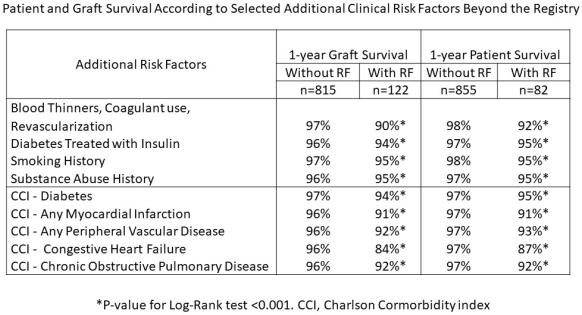Improving Prediction of Post-Transplant Death and Graft Loss with Expanded Clinical Data Collection
1University of Michigan, Ann Arbor
2Saint Louis University, St. Louis
3XynManagement, Inc, St. Louis.
Meeting: 2018 American Transplant Congress
Abstract number: 319
Keywords: Area-under-curve (AUC), Graft survival, Mortality, Risk factors
Session Information
Session Name: Concurrent Session: Kidney Complications: Late Graft Failure
Session Type: Concurrent Session
Date: Monday, June 4, 2018
Session Time: 4:30pm-6:00pm
 Presentation Time: 5:06pm-5:18pm
Presentation Time: 5:06pm-5:18pm
Location: Room 6E
US transplant centers are graded for patient and graft survival of their recipients based on comparison to risk-adjusted expectations using elements captured in the national registry. The combined impact of a set of additional risk factors has not been quantified.
A US kidney transplant center collected information on up to 20 literature-based risk factors (Table) in addition to the risk factors used by the Scientific Registry of Transplant Recipients (SRTR) for 935 patients transplanted between 2010 and 2016. One-year graft and patient survival were compared in those with and without the additional risk factors. Receiver-operating characteristic (ROC) curves were generated to compare the predictive accuracy of the standard SRTR-based models to augmented models including the additional risk factors based on the Area Under the Curve (AUC) metric.
Compared to absence of the risk factors, 1-yr patient and graft survival was significantly lower among patients with each risk factors (Table 1). Patients who experienced graft failure or death had higher Charlson comorbidities indices (mean 3.63 vs. 2.98 for graft and 3.92 vs 2.98 for patient survival; P<0.001).
Augmentation of the SRTR model with these additional risk factors improved predictive accuracy for post-transplant death, increasing the AUC by 7% (from 0.70 to 0.75). Similarly, inclusion of the additional risk factors also improved the AUC for graft failure by 4% (from 0.70 to 0.73).
Pending additions to the national registry, expanded data collection by centers and use of augmented risk models can better inform centers about the true risk of their patients and guide selection and management before and after transplant.
CITATION INFORMATION: Sung R., Magee J., Schnitzler M., Dzebisashvili N., Lentine K., Ly L., Axelrod D. Improving Prediction of Post-Transplant Death and Graft Loss with Expanded Clinical Data Collection Am J Transplant. 2017;17 (suppl 3).
To cite this abstract in AMA style:
Sung R, Magee J, Schnitzler M, Dzebisashvili N, Lentine K, Ly L, Axelrod D. Improving Prediction of Post-Transplant Death and Graft Loss with Expanded Clinical Data Collection [abstract]. https://atcmeetingabstracts.com/abstract/improving-prediction-of-post-transplant-death-and-graft-loss-with-expanded-clinical-data-collection/. Accessed December 20, 2025.« Back to 2018 American Transplant Congress

